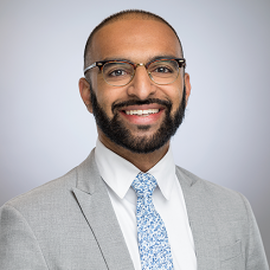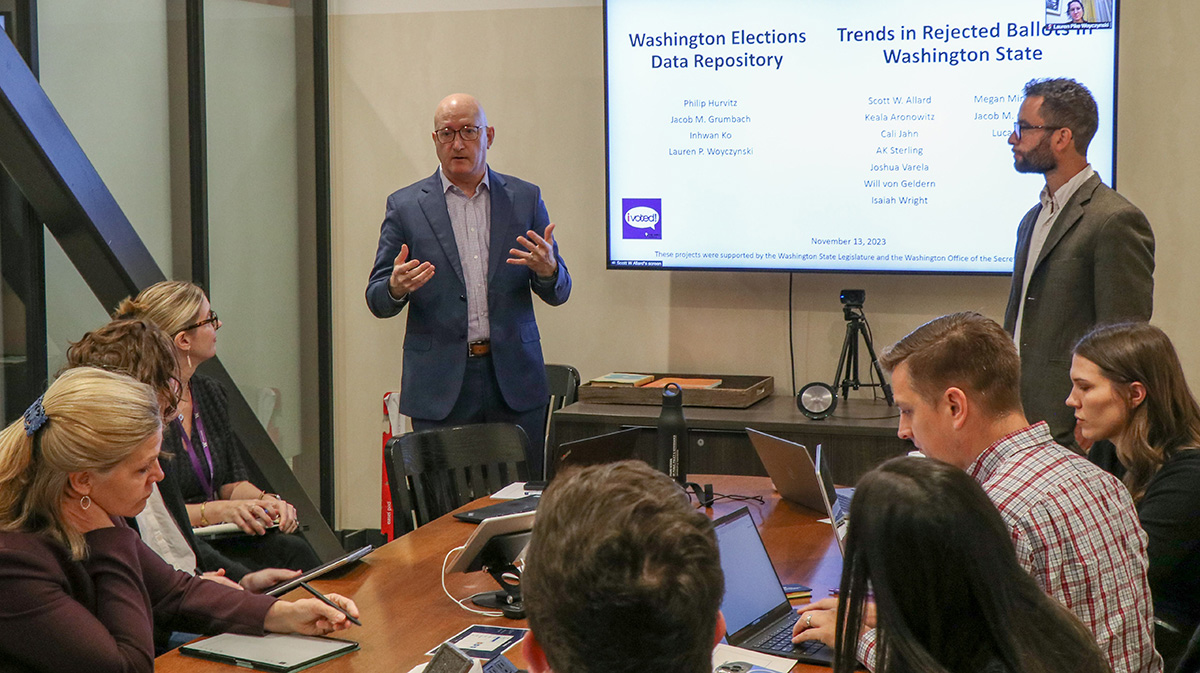
Raheem Chaudhry


The research team is:
General inquiries about the project may be addressed to: mariana.amorim@wsu.edu.
From July 2024 to June 2025, EPIC is:
Coming soon.
General inquiries about the project may be addressed to: evansepic@uw.edu.
Washington stands out nationally for its robust network of 34 community colleges and six public universities. The state has also earned recognition as a pioneer in longitudinal data systems that connect education directly to workforce outcomes. Building on these powerful foundations, we collaborate with state agencies, policy innovators, and diverse stakeholders to equitably transform Washington’s higher education landscape. Our dynamic initiatives have tackled transfer pathway redesign, expanded community college baccalaureate opportunities, improved data utilization in CTE programs, and forged strategic partnerships with individual institutions to boost student success.
This study poses several research questions to better understand voter experiences with ballot rejection and curing processes:
Key study components include:
Several key findings emerge about voters’ experiences with vote-by-mail in Washington State:
The report concludes with recommendations for research, policy, and practice to reduce the number of rejected ballots, increase ballot cure rates, and improve the voter experience in Washington State:
Ballot Envelope Design
Future Research
A Stronger Role for Community-based Organizations
Strengthening Elections Administration Practice
State Elections Law and Regulation
General inquiries about the project may be addressed to: evansepic@uw.edu.

We produce high-quality research, and research-to-practice information on the scale, implementation, and outcomes of bachelor’s degrees offered by community colleges nationwide.

Through partnerships with the Washington State Board for Community and Technical Colleges, individual community colleges, and others we research new and innovative approaches to meaningful education credentials.

As part of the Community College S-STEM Network (CCSN), an NSF sponsored research hub, we generate, translate and amplify research on low-income community college STEM student decision-making and pathways.

Our research focuses on the programs, quality, and academic and career outcomes of postsecondary CTE, especially CTE programs centered in community colleges.
Scholarly works published by our team are posted here as well as on the corresponding research project webpage. All of our reports, briefs, conference papers, academic publications and scholarly papers are externally reviewed by at least one peer reviewer who is a scholar in the field of expertise associated with the publication.

Washingtonians have been voting by mail for over a decade and voter turnout in Washington routinely is among the highest in the country. Despite the success of vote-by-mail, a research study by the Evans School of Public Policy & Governance at the University of Washington examined why ballots are rejected to improve the voter experience and inform efforts by state and county leaders to continue to reduce the number of ballots rejected in any election.
The Evans Policy Innovation Collaborative (EPIC) worked alongside the Secretary of State’s Office to explore ballot signature verification practices along with investigating individual voters’ understanding and communication around the signature verification process, and education and outreach methods. Through an analysis of voter- and county-level ballot data from the past 10 years of primary and general elections along with engagements, interviews, and surveys of county elections staff, individual voters, and community organizations, and the added help of a project advisory board, several key findings about voters’ experiences with vote-by-mail in Washington emerged –
Between 2012 and 2022, Washington State voters cast nearly 45 million ballots in primary and general elections. Annually, 25,000 to 35,000 ballots are rejected, primarily due to late arrival, and some for missing or mismatched signatures (0.5 to 0.6% of all ballots). There is evidence that voters of color often have higher ballot rejection rates than White voters. Voters of color, such as Hispanic and Asian voters, faced rejection rates double that of White voters in the 2020 General Election. Black voters experienced rejection rates 50% higher than White voters. Male-identifying voters and younger voters also had higher rejection rates, with nearly 5% of ballots from voters aged 18-25 being rejected in the 2022 general election. About 60% of ballots with signature issues have been corrected before final results are submitted since 2020.
NOVA and Northwest Public Broadcasting, launching a series on the significance and impact of data grabbed onto the importance of this work, particularly around the methods researchers employed to estimate race. Since Washington State does not collect racial data alongside voter registration, the study had to impute race to understand racial trends. While estimating race is not perfect, it is critical that we look at data to better understand how our systems, like electoral systems, impact and serve all people. All Washington voters should feel empowered and knowledgeable to vote.
The study concluded with a number of recommendations to improve the voter experience in Washington State and hopefully improve ballot rejection rates, including creating a universal ballot envelope design for all Washington counties, forging a stronger role and relationships with community-based organizations, encouraging increased opportunities for voters to update their signature on record, pursuing evaluation of innovative practices like text messaging and automatic signature verification, as well as plenty of opportunities for future research.
Policy textbooks abound but nearly all cover the same technical topics without any systematic analysis of how values drive policy decisions. In short, we face big questions that ought to center the perspective and experience of analysts who practice the art and craft of policy analysis:
These questions are enormously consequential when it comes to the role that policy analysis plays in addressing the urgent policy problems of our day.
In Spring 2025, we brought together policy analysts throughout the Pacific Northwest to explore questions of what policy analysis looks like in the field, how policy analysts perceive their analysis is used for public decision-making, and the type of training analysts need to excel in their work, especially in the context of values-powered policy analysis.
Project Team
Faculty:
EPIC Staff:
As governments continue to lean into commitments to equity and anti-racism, they grapple with the challenges of how to actionably update their policies and processes to better collaborate with and service their constituent communities. At the local level, community-led approaches to change have the potential to be particularly effective, but can be challenging to implement in an authentic and effective way. In the Pacific Northwest, there have been many efforts to engage in this type of work by incorporating approaches informed by behavioral science, which attempt to center how people experience and engage with government policies. However, there is still a lack of extensive evidence-based best practices in this space that take an equity-forward approach to the work. Due to this, conversations that center equity and anti-racism often occur separately from conversations that center person-informed design and behavioral science approaches to pressing local issues.
In Spring 2024, we brought together leaders in both the academic and practitioner communities to explore questions of how to provide guidance and evidence-based best practices for those working at the local level on these issues. Through the unique combination of stakeholders engaged we will leverage the current state of the scholarly literature, while also being mindful of the practical constraints and challenges faced by actors within this level of government.
Project Team
Faculty:
EPIC Staff:

Almost daily, we see the challenges from the breakdown in civic dialogue—in the news, in community meetings, in national politics. Yet at the same time, people are also acting to counter divisiveness, develop community solutions to shared challenges, and improve dialogue across differences.
Concerned by the increasingly common dysfunction in governance at state legislatures around the country, Denny Heck, the Lt .Governor of Washington State, reached out to leaders at the Henry M. Jackson Foundation, University of Washington, and Washington State University. Together, we realized civic health demanded our collective attention. The Project for Civic Health was born.
The Office of the Lt. Governor began by convening roundtables in five Washington counties with elected officials and community leaders. Small groups gathered to talk more about the state of civic health, and, in the course of doing so, reminded each other of how much we have in common. The roundtable conversations have been distilled into a report, Common Ground for the Common Good.
On October 19, 2023, the partners held a Civic Health Summit, where participants engaged in discussions sparked by the report that will be used to make recommendations for sustained action to improve our civic health in the State of Washington.
The Project for Civic Health was initiated by the Office of the Lieutenant Governor. Lieutenant Governor Denny Heck invited the Henry M. Jackson Foundation, the University of Washington Evans School of Public Policy and Government, and the William D. Ruckelshaus Center, a joint center of Washington State University and the University of Washington, to collaborate on the design and implementation of the project. The partnership was formed on a shared premise of concern for our democracy’s civic health. The partners agree that this problem is so complex that meaningful progress will require intentional and sustained effort. In other words, this is going to take a while. But we have observed an emphatic willingness to attack the problem, and an inspiring variety of efforts already underway in many Washington communities. So, yes, it may take a while, but we have many reasons to be encouraged.
The Project initially includes two components:
Roundtable Discussions
The Office of the Lieutenant Governor convened a systematic exploration of the nature of the problem, its causes, and possible solutions by undertaking a series of confidential roundtable discussions around Washington State with a diverse set of stakeholders. A contracted author distilled those conversations as well as certain contextual information in the following preliminary report.
This report reflects the views of the participants in the roundtable discussions. It is not intended to represent the views of the project partners. The report will serve as part of the basis for the Project’s second component, a day-long summit.
Read the report: Common Ground for the Common Good.
Civic Health Summit
On October 19, the partners held a day-long summit in which participants engaged in discussions sparked by the report that will be used to make recommendations for sustained action to improve our civic health in the State of Washington.
Read the Civic Health Summit Newsletter
Read the Civic Health Summit Proceedings
General inquiries about the project may be addressed to: evansepic@uw.edu.

Registered voters in Washington State will be receiving their vote-by-mail ballots in the next few days. Washingtonians have been voting by mail for over a decade and voter turnout in Washington routinely is among the highest in the country. Despite the success of vote-by-mail, a research study by the Evans School of Public Policy & Governance at the University of Washington has been examining why ballots are rejected to improve the voter experience and inform efforts by state and county leaders to continue to reduce the number of ballots rejected in any election.
For a ballot to be valid and counted, it must meet three conditions: Completed ballots must be placed in an official ballot drop box by 8 p.m. on election day or postmarked by election day. Ballot envelopes must be signed by the voter. And, that signature must match the voter’s signature on file with their county elections office. For most voters the signature to match is the one on your driver’s license or state ID, because people commonly register to vote when getting or updating their driver’s license and the Department of Licensing.
County elections offices process ballots and decide whether the signature from the ballot envelope matches what is on file. Ballots without a signature or without a matching signature are thus “challenged” and voters have the opportunity to “cure” or correct their ballot. Counties send out ballot cure letters within 24 hours of a ballot being challenged, which invites voters to submit by mail or in-person a signature verification that cures the ballot. If voters have a phone number on file, they also should receive a phone call from their county election office. Challenged ballots are rejected if they are not cured at the time election results are certified, which occurs about three weeks after election day.
Study director and Evans School Professor Scott Allard reports that roughly 98 to 99 percent of ballots cast in November elections since 2012 have arrived on time with an envelope signature that matches the voter’s signature on file. “Even with this level of success, far too many ballots are rejected each election,” according to Allard. Although each general election is a little different, the study finds that about one-half of rejected ballots in November elections without a presidential or midterm congressional election (a.k.a. off-off-year elections) are simply received late. “Off-off-year elections like those this November get less media attention and less public discussion, which makes it easier to forget to return your ballot on time,” Allard notes.
Project team member Calista Jahn observed several counties processing ballots in November 2022, “it is clear from watching county election offices work that they process ballots carefully and securely and receive training in signature matching that ensures integrity in the voting process. Our election workers are focused on ensuring elections have integrity and that all valid ballots are counted.” The study finds that about 1 in 8 rejected ballots lack a signature, with roughly one-third of rejected ballots challenged for signature mismatches in off-off-year elections.
UW researchers found, however, that about 60 percent of all challenged ballots in November elections are cured before counties certify their final election results. “While this shows that ballot curing processes work, we should still have it be a goal to reduce the number of ballots needing to be cured,” Allard said.
The Evans School study team final report will be delivered to the Secretary of State in early November, but other key findings stand out as voters prepare to fill out their ballots in the next few weeks.
With these results in mind, the study team offers three simple guidelines for voters this election season. “First, sign your envelope,” notes Professor Allard. “Second, when you sign your envelope – sign your name as you do on your driver’s license or state ID. Third, mail or deposit your ballot early – ideally the week before election day, which this year is on Tuesday, November 7, 2023. This will ensure your ballot arrives on time and that you have time to cure your ballot before election day, just in case you forget to sign the envelope or signed too quickly for there to be a good match.”
Voters can go to the Secretary of State elections website and follow their ballot through processing. Allard recommends that voters contact their county election offices with any questions they have about their ballot. He notes that voters also can go to their county election office websites to learn more about vote-by-mail and about ballot curing processes. “Sign your envelope, sign with your license signature, and return your ballot early,” encourages Allard.